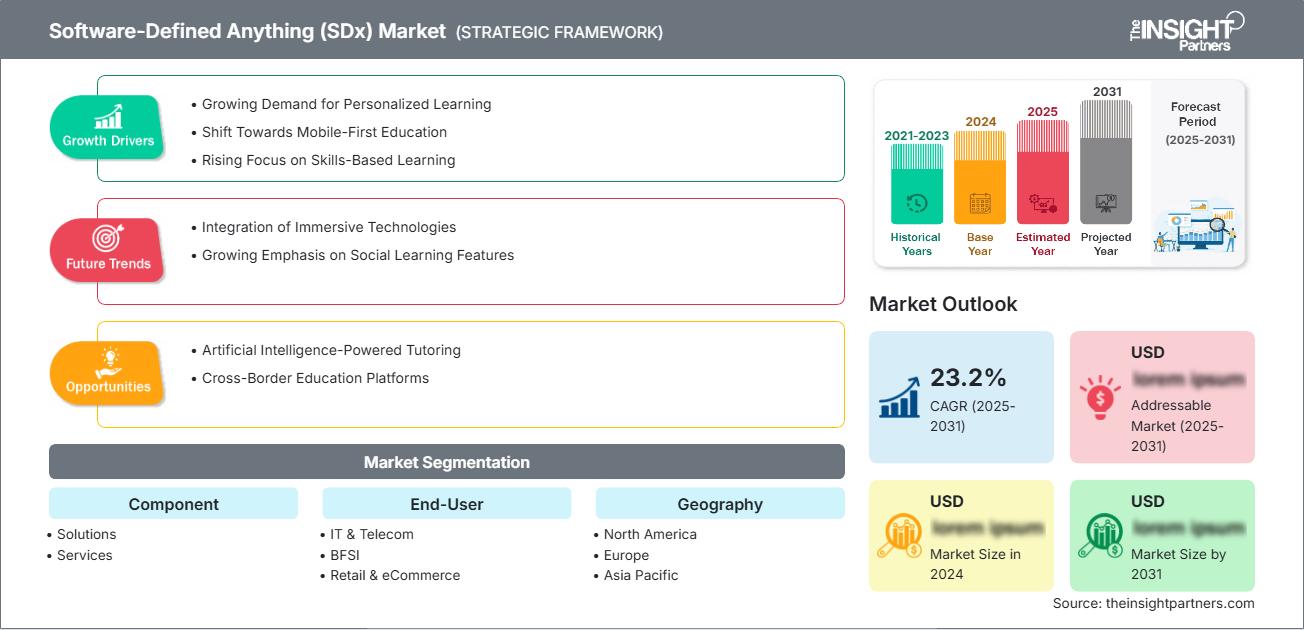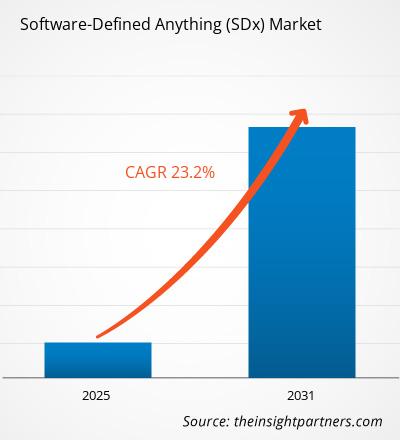The Software Defined Anything (SDx) Market is expected to register a CAGR of 23.2% from 2025 to 2031, with a market size expanding from US$ XX million in 2024 to US$ XX Million by 2031.
The report is segmented by Component (Solutions, Services); End-User (IT & Telecom, BFSI, Retail & eCommerce, Healthcare & Life Sciences, Manufacturing, Government, Others). The global analysis is further broken-down at regional level and major countries. The report offers the value in USD for the above analysis and segments
Purpose of the Report
The report Software Defined Anything (SDx) Market by The Insight Partners aims to describe the present landscape and future growth, top driving factors, challenges, and opportunities. This will provide insights to various business stakeholders, such as:
- Technology Providers/Manufacturers: To understand the evolving market dynamics and know the potential growth opportunities, enabling them to make informed strategic decisions.
- Investors: To conduct a comprehensive trend analysis regarding the market growth rate, market financial projections, and opportunities that exist across the value chain.
- Regulatory bodies: To regulate policies and police activities in the market with the aim of minimizing abuse, preserving investor trust and confidence, and upholding the integrity and stability of the market.
Software Defined Anything (SDx) Market Segmentation
Component
- Solutions
- Services
End-User
- IT & Telecom
- BFSI
- Retail & eCommerce
- Healthcare & Life Sciences
- Manufacturing
- Government
You will get customization on any report - free of charge - including parts of this report, or country-level analysis, Excel Data pack, as well as avail great offers and discounts for start-ups & universities
Software-Defined Anything (SDx) Market: Strategic Insights

-
Get Top Key Market Trends of this report.This FREE sample will include data analysis, ranging from market trends to estimates and forecasts.
Software Defined Anything (SDx) Market Growth Drivers
- Growing Demand for Personalized Learning: The increasing recognition that one-size-fits-all education models are ineffective has driven the adoption of smart digital education solutions. These platforms leverage artificial intelligence and machine learning to create personalized learning paths based on individual student performance, learning pace, and preferences. Advanced analytics track student progress in real-time, automatically adjusting content difficulty and learning methods to optimize comprehension and retention. The technology enables educators to identify learning gaps quickly and provide targeted interventions, while students benefit from customized feedback and recommendations. This personalization capability has become particularly crucial as educational institutions seek to improve learning outcomes and student engagement in diverse learning environments.
- Shift Towards Mobile-First Education: The ubiquity of mobile devices among students of all ages has catalyzed the development of mobile-optimized educational content and platforms. Educational institutions and content providers are prioritizing mobile-first approaches to ensure seamless access to learning materials across devices. This driver is supported by the increasing sophistication of mobile technologies, enabling interactive simulations, augmented reality experiences, and collaborative learning tools on smartphones and tablets. The mobility factor has become essential for delivering education to remote and underserved communities, while also accommodating the learning preferences of digital-native students.
- Rising Focus on Skills-Based Learning: The rapidly evolving job market and widening skills gap have intensified the need for practical, skills-based education solutions. Smart digital platforms are increasingly incorporating real-world problem-solving scenarios, virtual laboratories, and industry-aligned projects to develop job-ready skills. The integration of adaptive assessment tools helps measure competency levels and progress in specific skill areas. This approach enables educational institutions to offer more relevant, career-focused learning experiences while helping students build portfolios of verified skills and achievements that demonstrate their capabilities to potential employers.
Software Defined Anything (SDx) Market Future Trends
- Integration of Immersive Technologies: Virtual and augmented reality technologies are revolutionizing digital education by creating immersive learning experiences. Educational platforms are incorporating VR/AR elements to simulate complex scientific concepts, historical events, and practical training scenarios. This trend is particularly prominent in fields requiring hands-on experience, such as medical education, engineering, and vocational training. The decreasing cost of VR/AR hardware and improvements in content creation tools are accelerating adoption, enabling students to engage with interactive 3D models, conduct virtual experiments, and participate in realistic simulations that enhance understanding and retention.
- Growing Emphasis on Social Learning Features: Digital education platforms are increasingly incorporating social learning elements to foster collaboration and peer-to-peer learning. This trend reflects the understanding that learning is inherently social and that student engagement improves through interaction with peers. Platforms are implementing features like virtual study groups, peer assessment tools, discussion forums, and collaborative project spaces. These social features help create learning communities that extend beyond traditional classroom boundaries, enabling knowledge sharing and peer support while developing important soft skills like communication and teamwork.
Software Defined Anything (SDx) Market Opportunities
- Artificial Intelligence-Powered Tutoring: The development of sophisticated AI tutoring systems represents a major growth opportunity in the smart digital education market. These systems can provide personalized, round-the-clock learning support at a fraction of the cost of human tutors. Advanced natural language processing and machine learning algorithms enable these systems to engage in meaningful educational dialogues, identify conceptual misunderstandings, and provide targeted explanations and practice exercises. The potential to scale individualized tutoring services to millions of learners while maintaining consistent quality makes this an attractive opportunity for market players.
- Cross-Border Education Platforms: There's significant potential in developing platforms that facilitate cross-border education and cultural exchange. These solutions can bridge geographical and language barriers through real-time translation features, cultural adaptation of content, and international collaboration tools. The opportunity extends to creating standardized assessment systems that are recognized across countries, enabling students to pursue international education opportunities more easily. Providers can focus on developing platforms that support multiple languages, accommodate different educational systems, and facilitate the transfer of credits and credentials across institutions and borders.
Software-Defined Anything (SDx) Market Regional Insights
The regional trends and factors influencing the Software-Defined Anything (SDx) Market throughout the forecast period have been thoroughly explained by the analysts at The Insight Partners. This section also discusses Software-Defined Anything (SDx) Market segments and geography across North America, Europe, Asia Pacific, Middle East and Africa, and South and Central America.
Software-Defined Anything (SDx) Market Report Scope
| Report Attribute | Details |
|---|---|
| Market size in 2024 | US$ XX million |
| Market Size by 2031 | US$ XX Million |
| Global CAGR (2025 - 2031) | 23.2% |
| Historical Data | 2021-2023 |
| Forecast period | 2025-2031 |
| Segments Covered |
By Component
|
| Regions and Countries Covered |
North America
|
| Market leaders and key company profiles |
|
Software-Defined Anything (SDx) Market Players Density: Understanding Its Impact on Business Dynamics
The Software-Defined Anything (SDx) Market is growing rapidly, driven by increasing end-user demand due to factors such as evolving consumer preferences, technological advancements, and greater awareness of the product's benefits. As demand rises, businesses are expanding their offerings, innovating to meet consumer needs, and capitalizing on emerging trends, which further fuels market growth.

- Get the Software-Defined Anything (SDx) Market top key players overview
Key Selling Points
- Comprehensive Coverage: The report comprehensively covers the analysis of products, services, types, and end users of the Software Defined Anything (SDx) Market, providing a holistic landscape.
- Expert Analysis: The report is compiled based on the in-depth understanding of industry experts and analysts.
- Up-to-date Information: The report assures business relevance due to its coverage of recent information and data trends.
- Customization Options: This report can be customized to cater to specific client requirements and suit the business strategies aptly.
The research report on the Software Defined Anything (SDx) Market can, therefore, help spearhead the trail of decoding and understanding the industry scenario and growth prospects. Although there can be a few valid concerns, the overall benefits of this report tend to outweigh the disadvantages.
Frequently Asked Questions
What are the options available for the customization of this report?
What are the deliverable formats of the market report?
What are the future trends of the software defined anything (SDx) market?
What are the driving factors impacting the global software defined anything (SDx) market?
What is the expected CAGR of the software defined anything (SDx) market?
- Historical Analysis (2 Years), Base Year, Forecast (7 Years) with CAGR
- PEST and SWOT Analysis
- Market Size Value / Volume - Global, Regional, Country
- Industry and Competitive Landscape
- Excel Dataset
Recent Reports
Testimonials
Reason to Buy
- Informed Decision-Making
- Understanding Market Dynamics
- Competitive Analysis
- Identifying Emerging Markets
- Customer Insights
- Market Forecasts
- Risk Mitigation
- Boosting Operational Efficiency
- Strategic Planning
- Investment Justification
- Tracking Industry Innovations
- Aligning with Regulatory Trends





















 Get Free Sample For
Get Free Sample For